Australia’s wildflower meadows, prairies and woodlands are unique in our rich natural world but, still, garden centres and online stores push internationally standard wildflower mixes for sale.
Rather than filling your garden with poppies and cornflowers, consider the positive impact you can have on nature by planting your own Australian wildflowers.
More...
What is a Wildflower?
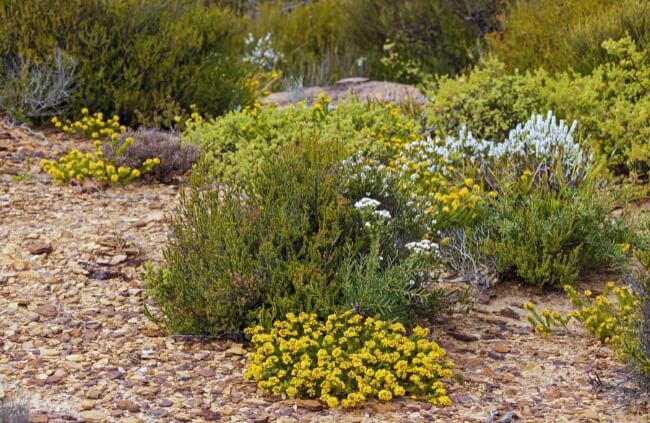
Wildflowers is a vague and general term, but is generally used to talk about annual, biennial and herbaceous perennial flowers. Because Australia offers such a diverse climate range, from cool and temperate conditions, right through to arid deserts and humid subtropical zones, the wildflowers that have evolved to colonise those landscapes are numerous and highly varied.
In this article, we’ll share hints and tips on what to plant in different zones, and a few different ways to plant wildflowers at home, whether you’re planting native flowers on a balcony or a ten-acre field.
But don’t let that restrict you, Australia’s native wildflowers are diverse and abundant, with prostrate shrubs, trailing succulents and clump-forming perennials that offer just as much to native wildlife and, often, even more colour for us lucky gardeners.
Read more about the varieties of native plants you can grow in Australia in our guide to Australian native flowers.
What are the Benefits of Planting Australian Wildflowers?
As well as the obvious benefits to wildlife, native wildflowers are one of the best, and easiest ways to bring nature into your garden. A naturalised garden, or even a formal garden with pops of native colour, is almost universally understood to improve your mental health.
Gardening by itself can be therapy, but we rarely get to just sit back and observe our gardens, especially with more manicured plots. Planting a wildflower meadow makes that simple, and at the same time, you’re inviting important native pollinators into your garden, and providing a habitat for ground-nesting creatures.
We keep our garden as a productive veggie plot for the most part, but one-third of the total ground area is meadow, long grass, or native flowers. And it’s not just for the benefit of nature. By inviting nature in, you can put it to work.
Those pollinators, attracted by the wildflower, actively improve crop pollination and make your veggie plot more productive.
Types of Wildflower & their Habits
OK, so I accept that wildflower is a general term, but there are simple ways to break it down. This breakdown is important because understanding what you plant, where and when will have a huge impact on the overall success of your wildflower garden.
There are three key categories: annuals, perennials (including biennials), and trees and shrubs. Each offers something different to your garden, and all are essential for a truly successful wildflower patch.
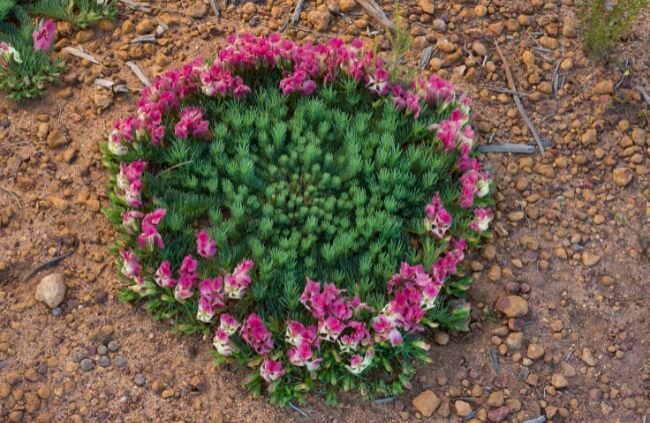
Perennial and biennial wildflowers
Perennial wildflowers are plants that flower in their first summer, and every year after. Some short-lived species flower for around five years, including most native daisies, but offer quick impact and a fuller display for the first few years.
They can help to establish a longer-lasting perennial meadow, packed with plants like billy buttons or strawflowers and flag iris.
Biennials take longer to establish, and flower in their second year before dying and setting seed. It will take a few years but plants like the sticky everlasting daisy (Xerochrysum viscosum) are best planted in autumn and treated as a biennial. They will set seed and spread in most soils, and offer seasonal shifts in annual or perennial meadows.
Annual Wildflowers
Annual wildflowers establish rapidly, but the full impact of a meadow, particularly in mixed grass, can take time. Australian annual flowers will develop fully and flower in their first year, but the ground will need some cultivation each year.
We’ll look in more detail at this later, but essentially, annual meadows work by setting seed, so new plants come back each year. The results are lusher, greener springs, and brighter summers, but winter meadows are generally made up of sparse grasses.
Australian Native Shrubs and Trees
And finally, the typically overlooked Australian wildflowers: our flowering trees and shrubs.
Australia has some of the most spectacular native deciduous trees on the planet, and whether you’re planting a meadow, or interplanting your borders, offering natural habitats, and native nectar sources to pollinators will be of far greater benefit to your garden than planting non-native species.
Planting deciduous native trees also creates new planting possibilities for more diverse wildflowers beneath them. Some shade-loving understory plants, particularly from sub-tropical zones and woodlands, offer incredible colour in spring before your trees burst into flower.
Ways of Planting Native Australian Wildflower
Planting native wildflowers doesn’t always have to mean planting a meadow. It can mean planting in pockets in borders, rows in raised beds, or using the natural properties of trailing native plants in hanging baskets and pots.
And with some stunning coastal flowering succulents like Portulaca, there are even options for rockeries and the gaps between your paving or brickwork.
A meadow is, traditionally speaking, an area of mixed flower and grassland. The coexistence of both can be difficult to establish, but is the most dramatic way to include wildflowers in your garden.
But you can cheat. Using perennial herbaceous wildflowers means you can plant directly into your lawn. Planting like this, if you choose your flowers wisely, can have a similar effect to annual meadows, but with more robust plants that will come back year after year with less maintenance. Space young plants about a foot apart, with uneven spacing for the best effect.
Bulbs and tubers can work well like this too – planted straight into the lawn and left to flower – it is also an ideal medium for anyone who prefers a flat summer lawn but wants native colour in spring.
Native Wildflower for Different Climates
There’s no way of writing this article without sharing tips on Australia’s different climates. We live in a spread population, with towns, cities and suburbs in some of the hottest places on earth, and some of the wettest, but there are also cooler, more temperate zones in Australia.
The wildflowers we plant in each part of Australia should be as reflective as possible of where we live. That doesn’t mean directly replicating nature. You are a gardener after all. But it does mean listening to your soil, the weather, and what’s thriving around you.
Below, we’ve listed some of the most effective Australian wildflowers to plant, depending on the sort of climate you’re in.
Australian Wildflower for Cool Climates

Use dramatic wildflowers like Waratah (Telopea speciosissima) for ground-cover impact. Cooler climates can support a wider range of non-natives, but focusing on a select few species of native wildflowers – or even just one, will have a better effect.
The best wildflowers for cool Australian zones are:
- Fringe Lily (Thysanotus multiflorus)
- Winged Everlasting Sandflower (Ammobium alatum)
- Waratah (Telopea speciosissima)
- Pressed Hair Buttercup (Ranunculus pascuinus)
Australian Wildflowers for Tropical Zones
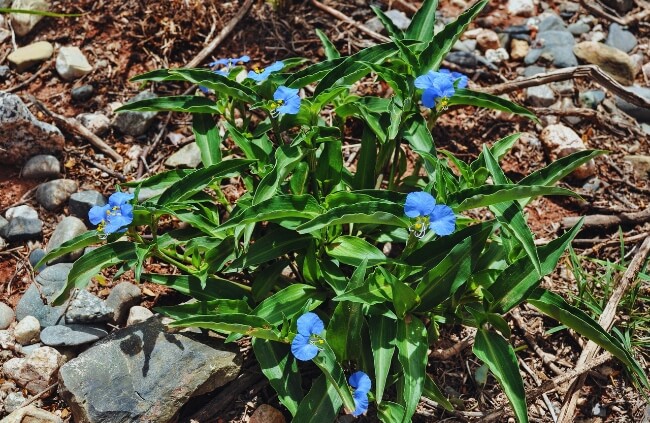
Tropical Australia offers an exceptional habitat range for wildflowers. Most of our wonderful native flora prefers free-draining soil but reasonable humidity, and the longer the season, the more you can get out of your backyard.
So in tropical and subtropical zones, your choice is fairly limitless, provided you avoid some of the cool climate plants above.
The best wildflowers for tropical Australia are:
- Dayflowers (Commelina)
- Byblis liniflora
- Beach Bean (Canavalia rosea)
- Lilly Pilly (Syzygium smithii)
- Hibiscus
- Pink Billy Buttons/ Bachelor Buttons (Gomphrena canescens)
Australian Wildflowers for Arid Zones
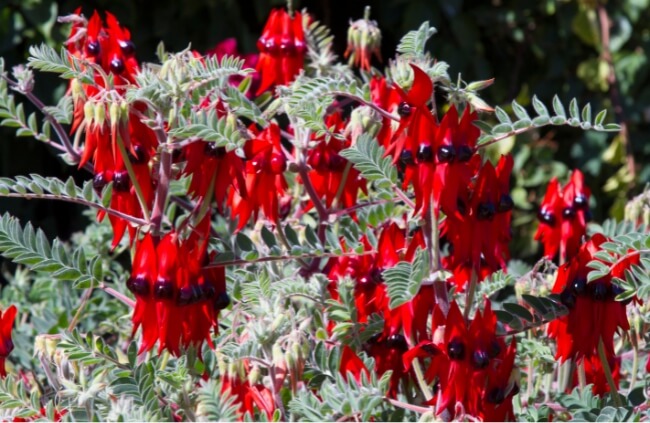
Gardening in arid climates is always tough, but there are some spectacular desert wildflowers that grow perfectly in free-drained and dry spots. Some of the below will work equally well in mixed meadows on grassland, but their specialism is growing where nothing else will.
And planted in large, single-species swathes, they aren’t just a recreation of nature, but an improvement on it.
The best wildflowers for arid parts of Australia are:
- White Correa (Correa alba)
- Boronia
- Sturt's Desert Pea (Swainsona formosa)
- Billy Buttons (Calocephalus platycephalus)
- White Paper Daisy (Rhodanthe floribunda)
Australian Wildflowers for Temperate Zones
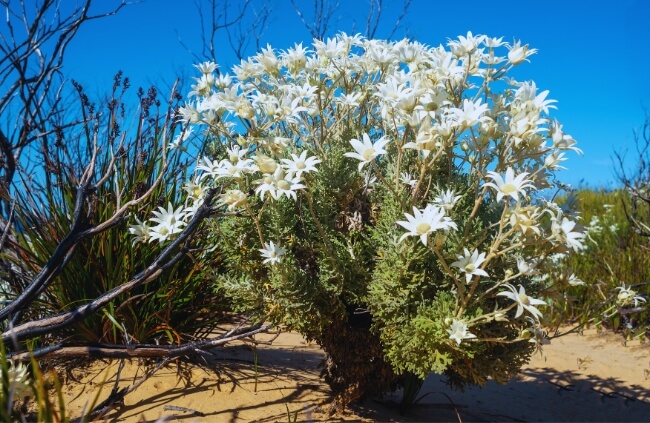
Temperate zones include Sydney, NSW and most of South Australia. They are the easiest spaces to garden and come with the simplest selection – largely down to plants being easier to come across, and the fact you don’t have to hunt down specialist seeds.
Some of our best-known and most floriferous wildflowers hail from temperature regions and will grow just as well in meadows as in pots and containers.
The best wildflowers for temperate Australia are:
- Blue Rottnest Island Daisy (Trachymene coerulea)
- Fairy Fan Flower (Scaevola aemula)
- Flannel Flower (Actinotus helianthi)
- Trigger Grass (Stylidium graminifolium)
- Pink Rock Orchid (Dendrobium kingianum)
Planting Australian Native Wildflowers
The best, and cheapest way to plant Australian wildflowers is to sow directly where they are to grow. That means preparing clear earth, where the seeds can be in contact with the soil.
But you can plant plugs, or mature plants too, depending on whether you’re growing perennial wildflowers, shrubs or annuals.
There are some wonderful wildflower mixes to buy online that will work in most climates.
Preparing the Ground for a Native Wildflower Meadow
Drainage for native wildflowers in Australia should be free-draining, or well-drained. Nearly all native annuals require good drainage to thrive and can become anaemic, and even fungal if overwatered.
There are a handful of bog-loving natives that will adapt to various conditions and are ideal for low-lying sites that are prone to flooding, but in most cases, you will need to prepare the soil for native wildflowers by cultivating, treading, and then raking smooth.
Direct sowing
Nearly all annual native wildflowers work best from seed, so if you’re planting in a border add a shallow layer of compost and rake it through the soil so the top 5cm of earth is loose enough for young roots.
If you’re planting into existing grass for a mixed meadow effect, you’ll need to scarify the lawn so that there is visible soil. Grass is an incredibly tough plant, and an established lawn will out-compete most seedlings.
- Start by raking your entire lawn. Remove any moss, or perennial weeds, particularly those with taproots like dandelions.
- Sow wildflower seed at roughly one handful per metre squared, and then water it in well. Repeat that watering every day for the first week, and then once a week until it is growing well.
- Avoid the temptation to feed the soil. As seeds are germinating, the fertiliser will be taken up by the grass, and have the opposite of the desired effect.
Sowing Indoors, and Planting Plugs
If you’re planting Australian natives outside of their normal climate zone, or starting a wildflower patch with perennials and biennials, you can save on bare garden soil while they develop by planting indoors first.
For many varieties, this can be as simple as planting in 4-5cm plug trays, and planting the plugs once top growth has developed, but for others (particularly the larger perennial wildflowers) it's best to sow them in individual pots, and grow them in until they are semi-mature, and plant them in their second year. That way, by the time they’re in the garden you’ve got instant impact.
Caring for Native Wildflowers
There are three ongoing care tips for wildflowers, regardless of how to grow them. None are complicated, but they all come with a choice. And remember, we’re all gardeners here.
This isn’t about conserving natural landscapes, it's about creating them in controlled settings. Some of you will want to leave annual meadows to go to seed and die back naturally, while others will plant native bulbs.
The nutritional and care needs of different flowers are never the same. Use the tips below to guide you.

Reseeding and Resowing Native Wildflowers Each Year
If you choose locally native wildflowers that you know work well in local parks or nature reserves, then you shouldn’t need to re-seed your meadow planting. However, for more varied meadows, or wildflowers grown amongst other border planting or pots, you will need to re-sow annual plants every year.
Selecting regional wildflower means that it will usually self-seed happily into your garden soil, and germinate when it's ready. This saves the hassle of reseeding each year.
The Best Feeds and Fertilisers for Native Wildflowers
There is no need to fertilise wildflowers or feed it like a lawn. But if you cut back each year for winter tidiness, you are removing vital nutrients and taking potential worm food away. The result is compacted soil that is quickly depleted of pre-existing nutrients.
Wildflowers thrive in nature by colonising wide landscapes and dying back in an annual rotation. This is just as true for annual flowers as it is for perennials. Even trees and shrubs rely on rotting leaf litter to boost soil nutrition.
So either feed your wildflowers with a balanced liquid feed or leave them to die back naturally. If you prefer a neater finish, you can cut them back once the seed heads have dried and let the top growth rot down. Next year’s flowers will come through, and the soil will be better for it.
When to Cut Back Native Wildflowers
Cutting back native wildflowers is a choice, not a chore. If you prefer to keep wild habitat in the garden over winter, then leave it uncut, and remove dry growth in spring.
Dried wildflowers retain structure in the garden over winter, as well as offering habitat though. While it can slow the start of spring, leaving uncut meadows will support more insect life, and can mean fewer pests in the garden.
Enjoy the Natural Beauty of Australian Wildflowers in Your Garden
How you grow native wildflowers is up to you, but there is one rule you should always stick to: listen to nature. Australian natives are wonderful, richly scented, boldly coloured beings. You don’t need to look that far for something that will transform your garden.
So instead of creating a false landscape, plant things that grow well near you. Treat them kindly, and let them feed themselves with their own dried leaves or stems.
It can take a few years to really see the impact of an Australian wildflower patch, but it’s worth the wait. You’ll save hours of gardening time each year by planting native wildflowers, meaning more time to enjoy your garden.
Published on June 6, 2023 by Nathan Schwartz
Last Updated on June 24, 2024




